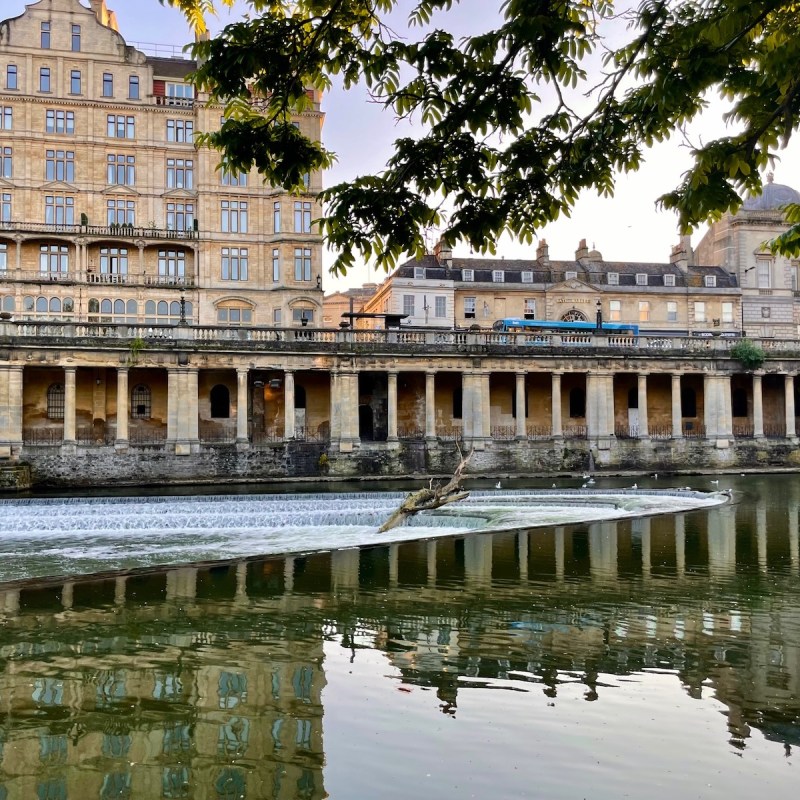
The UNESCO World Heritage City of Bath attracts millions of visitors every year. Some, like the Romans before them, come to enjoy the spring-fed thermal waters, while others enjoy the ambiance and architecture of this charming city just 2 hours west of London.
Videos by TravelAwaits
The city developed around the ruins of the ancient Roman settlement called Aquae Sulis, founded in 70 AD. Bath is sometimes referred to as the “golden city” for the color of the limestone used to build the Georgian period buildings, adding to the city’s unique character. Bath has remained a magnet for wealthy Londoners and visitors from further afield seeking a retreat for a weekend or longer. While I did not experience everything Bath offers, I tried.
My visit to Bath was partially sponsored, however, all opinions are my own.

1. The Roman Baths
Two-thousand years ago, the Romans claimed the area around the bubbling hot springs that is today the historic center of the city of Bath. Originally, it was called Aquae Sulis to honor the goddess Minerva. It was not developed as a bath house but as a religious site. There is evidence that others came here to worship earlier than the Romans.
The famous pool that everyone sees in photos of the Roman Baths is fed by one of three thermal springs. The columns were added in the Victorian era. The entire complex is much larger than just this spring-fed pool.
Plan to spend about 2 hours touring the museum. You’ll learn about the history of the Roman development and how the town eventually became a spa destination. The site has been through many changes over its long history.
Fascinating Fact: The springs that feed the Roman Baths are the same springs discovered by the Romans and they still produce 250,000 gallons of water, every day!

2. Bath Abbey
If you’ve spent a lot of time in England, you may think there’s no need to visit yet another church. Here’s a tip: The beautiful, fan-vaulted ceiling in Bath Abbey was created to draw your gaze upwards towards the heavens. I predict you’ll have a sore neck. Here’s another tip: Bath Abbey was the coronation church of Edgar, crowned in 974 as the first King of all of England.
Take a tour of the bell tower and climb the steps (212) for excellent views of the city. Bath Abbey is a parish church, and as such, it may be closed at times for services and events.

3. Afternoon Tea
While in Bath, English tea is a must. It doesn’t get any better than at the Roseate Villa, often rated as the number-one spot for tea in Bath. On a pretty day, you can sit in the garden, which is quite a lovely experience. My absolute favorite treat was the house-made scones with Cornwall-clotted cream; there really is nothing better than Cornwall-clotted cream. Note that there are options for vegan tea lovers as well.

4. Thermae Bath Spa
Thermae Bath Spa opened in 2007, but the water is the very same that feeds the old Roman baths. There are various treatment rooms offering infrared saunas, a cold plunge, a traditional sauna room, and my favorite, the celestial relaxation room created in honor of William Herschel who discovered the planet Uranus while living in Bath.
The highlight of the spa is the rooftop thermal swimming pool with fantastic views over the city. There’s also a beautiful indoor pool with lounge chairs.
There are lockers and changing rooms and you’ll be given a robe and slippers, though you’ll need to bring your own bathing suit.
5. Taste Local Cheese
Did you know that Somerset County is home to some of England’s most delicious cheeses? It’s also where cheddar cheese originated and it is still made there today. A great example is Montgomery’s Farmhouse Cheddar. To try some of these incredible cheeses, check out these cheesemongers in Bath.
The Fine Cheese Co.
The Fine Cheese Co. is much more than a cheesemonger. In addition to retail, they also export British artisan cheeses, specializing in traditionally made, unpasteurized cheeses you cannot find anywhere else. Bath Fine Cheese Co. also has a restaurant offering desserts, coffee, and more. This is not a place to dash in and out.
Bath Soft Cheese Co.
The owners of Bath Soft Cheese Co. have a family history of cheese-making that dates to the early 1900s. Today, they still use milk from their own herd. Bath Blue Cheese has won in the World Cheese Awards from among 2,700 entries. They do not have a shop in Bath, but just a short drive outside of the city, there’s a shop and restaurant at the farm and kids can visit the farm animals.

6. Take A Cruise On The Avon River
Most visitors to Bath forget that it is on the Avon River. Since you most likely won’t have your own boat, take a tour with Bath Adventures and discover Bath from the water. This 30-minute tour takes you from Bath Quay to Pulteney Bridge.
Along the way, a guide will point out sites along the river and give you a bit of history, too. You’ll pass the Half Penny Bridge, St. John’s Church with the highest spire in Bath, and the old mill. You’ll also get a great view of the Pulteney Bridge and the weir. Afterward, join a guide for a 50-minute walking tour of Bath taking in the sites and offering a lot of insider tips. I found this a fun way to quickly immerse myself in the city.
7. The Museum Of Astronomy
In 1781, the planet Uranus was discovered, via a homemade telescope, by William Herschel. William and his sister Caroline were both astronomers and their home in Bath is now the Herschel Museum of Astronomy.
Though William is credited with the discovery of Uranus and with innovations in creating the telescope, Caroline was a noted astronomer too and became the first female astronomer to discover comets and nebulae. She was one of the first two women recognized by the Royal Astronomical Society. A visit to this museum is a must for astronomy geeks or anyone with a curious mind.

8. Lacock Village
If you love Harry Potter, Downton Abbey, Jane Austen films, and medieval market villages, a day trip to Lacock Village is for you. Only 20 minutes from Bath, there are numerous locations throughout the village that have played starring roles in many productions. You will recognize the interior of the Abbey as it was used to film scenes at Hogwarts in several Harry Potter films. Lacock Abbey is fascinating as it was once both an abbey and the home of photography pioneer, William Henry Fox Talbot. Lacock Village is owned by the National Trust. I toured with In and Beyond Bath who picked me up and then dropped me back at my hotel. However, you can arrive there by public transportation, Uber, or you can rent a car.
Where To Stay
The best way to experience Bath is to stay in the historic center. For a modern hotel experience just steps away from the Roman Baths, Apex City of Bath Hotel is a good choice. A four-star property, it has 177 spacious rooms including family rooms and accessible rooms.
There’s a nice restaurant on site that offers discounts for kids under age 17. Bonus: There’s an indoor heated swimming pool, sauna, and gym. This is a good location for families, couples, and business travelers. Note that there is no parking at the hotel but the car park is only 5 minutes on foot. Rooms are reasonably priced starting at 99 pounds ($125.67) per night.
The Hotel Indigo is located steps from Bath Abbey and is housed in a gorgeous building designed by one of Bath’s premier Georgian architects, John Wood the Elder. Part of the Intercontinental Hotel Group, this 166-room property is a mix of Georgian, modern, and avant-garde that may overwhelm some. Rooms are themed and some have been adapted to be accessible. There are no family rooms and rates begin at 145 pounds ($184.07) in the low season.
Related Reading:

